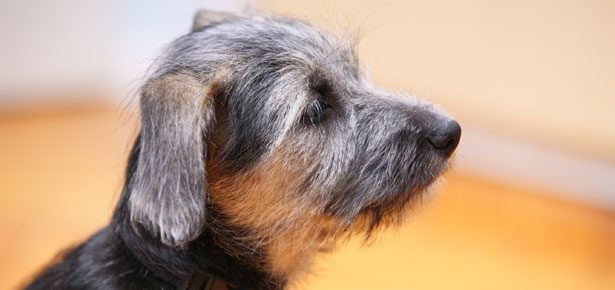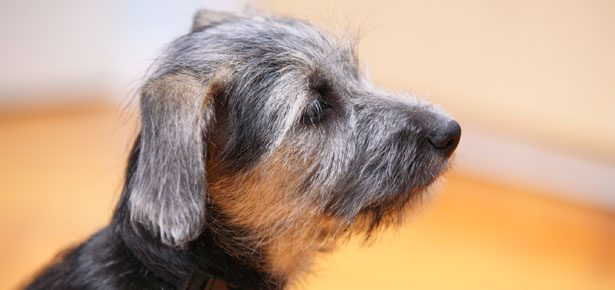

The Purposeful Mutt
The Purposeful Mutt
My friend Bob walks dogs in the University District of Seattle. He's a rangy Canuck with a mad scientist look, Apache cheekbones, windblown, wiry hair, and a pair of fogged Ben Franklin reading glasses parked far too low on his nose to function as anything but shoelace checkers. He cruised by the coffee shop the other day with a "doodle," or more properly a Labradoodle- a hybrid we once referred to as mutt, mongrel, or mixed breed.
"This is Gloria," he said, professorial in nature despite the week-old growth filtering onto his cheeks and chin.
"Poodle mix?" I asked, the dog bouncing around, happily licking at Bob's other charge, an overweight Nova Scotia Duck Tolling Retriever aptly named Moose.
"Labradoodle," he corrected. "Her owners are quite adamant about that."
"I stand corrected."
"Comes from the best Australian stock, mind you," he said mockingly.
"They really know their doodles down under."
He sighed and brushed wet hair from his face. "I suppose. Moose here doesn't seem to care much for her, though."
"A result of his more patrician pedigree, no doubt."
"Perhaps," said Bob, restoring Gloria's heel position and heading off in the rain. "Or maybe he just doesn't like her," he added, moving Moose over to his right side to spare him from another tongue lashing.
"See you, Bob."
The dogs I've owned have all been mutts. Road warriors, strays, quasi-feral survivors, reservation babies. Every time I'm due for a new dog I always imagine getting a Bullmastiff or GSD or Chocolate Lab, or something else "pure," something predictable and sure. But every time, I get suckered in, I weaken- I save an errant Chow/Golden or a Pit/shepherd or Cairn/Schnauzer, or a Rottweiler/GSD (thank goodness for that one, right Lou?). Then they live for sixteen years, suffer few medical issues, and, by and large, behave admirably. One of those particular mutts happened to also become one of the greatest dogs of our time, but that's another story.
Point is, I get mutts. I dig their madcap looks, their behavioral blending and hidden genomes, their unpredictability and vigor. I admire their unsavory histories, colorful beginnings, and unlikely survival stories. Mutts for me define the spirit of the dog; they have adapted, and survived.
But what if we force the issue? Rather than a Poodle and a Lab meeting secretly in the park for some taboo nuptials, what if we purposefully mate them, for the direct intention of creating a litter of mixed breed puppies, in hopes that they will possess the positive attributes of both parents, and few of the negatives? A Lab with a non-shedding coat? A Poodle with an unconquerable desire to fetch a ball?
"Hybrid" is a term used to describe one of these designer mutts- a deliberate attempt to engineer a new type of dog who benefits from the good traits of the parent breeds, while having the potentially bad traits muted. At least that's the intent. One of the first of these I recall seeing was the "Puggle," or Pug/Beagle. The Pug, a cool little breed with breathing, orthopedic and eye issues, and a habit of snoring and farting, was mixed with a Beagle, a delightful little hound with a penchant for baying at the most inopportune times, and for following its nose instead of its owner. Puggle puppies would supposedly be quieter, less flatulent, and more orthopedically sound, and have less of a desire to follow whatever scent happened to waft by.
In practice, it didn't often turn out that way. Dog breeding, especially for neophytes, isn't simple math; sometimes the hybridized puppies would have all the desirable qualities, but at other times, all of the undesirables. A farty, barky, snoring dog with bad knees? No thanks. Basically, any first generation breeding between purebred dogs is never that predictable- just like mutts since the dawn of time.
Experienced breeders of any species of animal know that, to create the best possible results, one must first choose parents who best reflect the traits one wants in the offspring. And so, if one is hoping for a less barky Beagle, the best strategy is not to breed a Beagle to a Pug (or Shiba, or Basenji for that matter), but to find the quietest Beagle parents possible and then breed them. But the hybrid movement's aim, in my opinion, is focused more on creating a novel aesthetic-something cute and marketable. The Puggle surely is that.
Puggle breeders, sure they are onto something, keep fine-tuning, in hopes of creating that perfect mix of traits. But, as they keep doing so, do they not eventually arrive at some new "breed," and therefore defeat the very purpose of the hybrid, namely an improved healthful vigor, unlike the "purebreds" they hope to compete with? In homing in on specific traits, the hybrid breeder narrows down the gene pool, and arrives at something contradictory to their most impressive selling point.
It's been done before. The most successful "hybrid" of all time? In my opinion, it's the German Shepherd Dog. Though plenty of shepherd-like dogs existed in Germany back in the late 19th Century, it wasn't until 1899 that Captain Max von Stephanitz and a few others figured out how to create the perfect mix of existing herding and farm dogs, coming up with the super dog we now know. Capable of not only herding, guarding and tracking with the best of them, The GSD can make a great family dog, and has, in my opinion, a near simian capacity for learning. In all, despite some structural problems, a winning attempt at creating a "designer" dog.
Other breeds such as the Bullmastiff, American Staffordshire Terrier, English Bulldog, and Miniature Pinscher, to name a few, have all been recently created to serve specific needs, with varied success, in my opinion. Really, all breeds were at some point manufactured from existing breed-types, to attain some specific appearance and function.
The point I make is that the above dogs are now considered "purebred," and as such no longer carry the stigma (or the perceived advantages) of being a hybrid. They can and do suffer from inherent medical or behavioral issues, caused by a finite gene pool, in comparison to true mixed breeds. And so, the main selling point of hybridization today, namely better health through genetic variation, ebbs. The ultimate goal of a Labradoodle or Puggle breeder then- some ideal standardization of desirable traits- defeats the very purpose of the exercise.
So then, does the "purposeful" mutt lose it's appeal? Is chance a key ingredient in the creation of a truly special mongrel? My own opinion is a cautionary yes, with some caveats. A puppy produced by two behaviorally unsound dogs will have little chance of becoming an outstanding pet. Likewise, two "high maintenance" breeds who just happen to mate have less of a chance to produce good offspring. I won't mention any particular breeds for fear of literary crucifixion- but you know which I mean. Mixing a breed plagued by inherent structural issues with a breed known for being somewhat standoffish- well, it's not going to work out well too often.
That said, I do have my mix prejudices. I do not think I have ever met a Shepherd/Rottweiler I did not like. Lab/Rott mixes, Lab/Shepherds, Newfoundland/Goldens, Cairn/Corgis- all interesting and memorable mixes. I suppose I think that any dog with a bit of GSD or Lab throw into the pot has got to be a decent dog, but hey, that's my own breed bigotry talking.
The dog's form and function has been manipulated by us for thousands of years, mostly for added utility, but recently for aesthetics, and even retail considerations. I guess my desire is this: How about we take a holiday from mucking around with their genetics, and simply enjoy whatever wonderful slip-ups happen by?
Join the newsletter and never miss out on dog content again!
"*" indicates required fields
By clicking the arrow, you agree to our web Terms of Use and Privacy & Cookie Policy. Easy unsubscribe links are provided in every email.